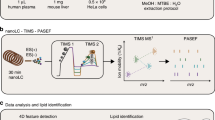Abstract
This protocol allows the accurate quantification of cell-penetrating peptide (CPP) cellular uptake by matrix-assisted laser desorption/ionization–time of flight mass spectrometry (MALDI-TOF MS). Quantification is based on the use of an internal standard with same chemical structure as the analyte but labeled with a stable isotope. The analyte and the standard can both be obtained by standard solid-phase peptide synthesis using commercially available amino acids. They are functionalized by biotin to allow their easy purification before MALDI-TOF MS analysis. The method allows determination of the amount of intact internalized peptide and the identification of potential intracellular digests. It can be used to simultaneously compare the uptake of several peptides, and can also be applied to the quantification of peptidic cargoes and the study of their intracellular stability. It is therefore a potent tool to study the mechanisms of CPPs internalization and to select new carriers for drug delivery. This protocol will take approximately 5 hours for the analysis of 12 samples (not including the time for cell incubation with peptides).
This is a preview of subscription content, access via your institution
Access options
Subscribe to this journal
Receive 12 print issues and online access
$259.00 per year
only $21.58 per issue
Buy this article
- Purchase on Springer Link
- Instant access to full article PDF
Prices may be subject to local taxes which are calculated during checkout


Similar content being viewed by others
References
Dietz, G.P. & Bahr, M. Delivery of bioactive molecules into the cell: the Trojan horse approach. Mol. Cell Neurosci. 27, 85–131 (2004).
Burlina, F., Sagan, S., Bolbach, G. & Chassaing, G. Quantification of the cellular uptake of cell-penetrating peptides by MALDI-TOF mass spectrometry. Angew. Chem. Int. Ed. 44, 4244–4247 (2005).
Balayssac, S. et al. Comparison of penetratin and other homeodomain-derived cell-penetrating peptides: interaction in a membrane-mimicking environment and cellular uptake efficiency. Biochemistry 45, 1408–1420 (2006).
Gobom, J. et al. Detection and quantification of neurotensin in human brain tissue by matrix-assisted laser desorption/ionization time-of-flight mass spectrometry. Anal. Chem. 72, 3320–3326 (2000).
Aussedat, B., Sagan, S., Chassaing, G., Bolbach, G. & Burlina, F. Quantification of the efficiency of cargo delivery by peptidic and pseudo-peptidic Trojan carriers using MALDI-TOF mass spectrometry. Biochim. Biophys. Acta 1758, 375–383 (2006).
Derossi, D. et al. Cell internalization of the third helix of the Antennapedia homeodomain is receptor-independent. J. Biol. Chem. 271, 18188–18193 (1996).
Vives, E., Brodin, P. & Lebleu, B. A truncated HIV-1 Tat protein basic domain rapidly translocates through the plasma membrane and accumulates in the cell nucleus. J. Biol. Chem. 272, 16010–16017 (1997).
Rothbard, J.B. et al. Arginine-rich molecular transporters for drug delivery: role of backbone spacing in cellular uptake. J. Med. Chem. 45, 3612–3618 (2002).
Hallbrink, M., Oehlke, J., Papsdorf, G. & Bienert, M. Uptake of cell-penetrating peptides is dependent on peptide-to-cell ratio rather than on peptide concentration. Biochim. Biophys. Acta 1667, 222–228 (2004).
Kaplan, I.M., Wadia, J.S. & Dowdy, S.F. Cationic TAT peptide transduction domain enters cells by macropinocytosis. J. Control Release 102, 247–253 (2005).
Acknowledgements
We thank A. Joliot and A. Prochiantz for fruitful discussions.
Author information
Authors and Affiliations
Corresponding author
Ethics declarations
Competing interests
The authors declare no competing financial interests.
Rights and permissions
About this article
Cite this article
Burlina, F., Sagan, S., Bolbach, G. et al. A direct approach to quantification of the cellular uptake of cell-penetrating peptides using MALDI-TOF mass spectrometry. Nat Protoc 1, 200–205 (2006). https://doi.org/10.1038/nprot.2006.30
Published:
Issue Date:
DOI: https://doi.org/10.1038/nprot.2006.30
This article is cited by
-
A cationic motif upstream Engrailed2 homeodomain controls cell internalization through selective interaction with heparan sulfates
Nature Communications (2023)
-
A MALDI-TOF-based Method for Studying the Transport of BBB Shuttles—Enhancing Sensitivity and Versatility of Cell-Based In Vitro Transport Models
Scientific Reports (2019)
-
A direct label-free MALDI-TOF mass spectrometry based assay for the characterization of inhibitors of protein lysine methyltransferases
Analytical and Bioanalytical Chemistry (2017)
-
Quantitative fluorescence spectroscopy and flow cytometry analyses of cell-penetrating peptides internalization pathways: optimization, pitfalls, comparison with mass spectrometry quantification
Scientific Reports (2016)
Comments
By submitting a comment you agree to abide by our Terms and Community Guidelines. If you find something abusive or that does not comply with our terms or guidelines please flag it as inappropriate.



